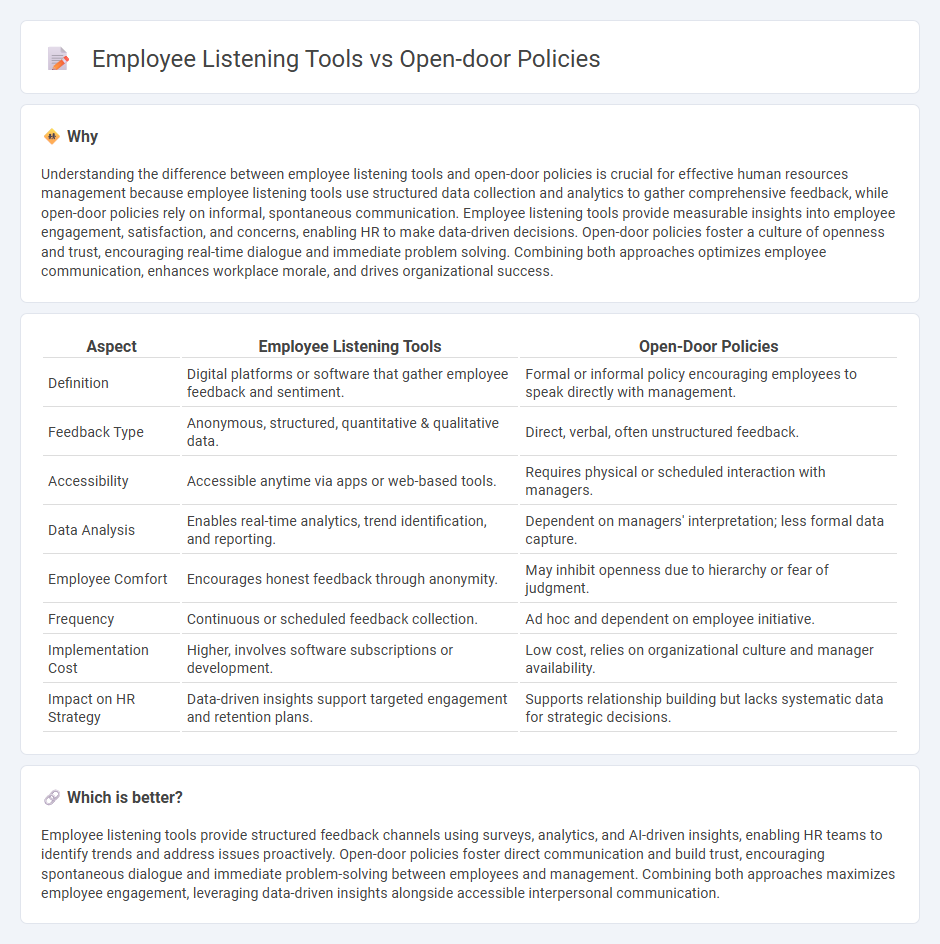
Employee listening tools harness technology to gather real-time feedback, enabling HR teams to analyze trends and address concerns efficiently. Open-door policies promote transparency and direct communication by encouraging employees to share ideas and issues face-to-face with management. Discover how these strategies transform workplace engagement and improve organizational culture.
Why it is important
Understanding the difference between employee listening tools and open-door policies is crucial for effective human resources management because employee listening tools use structured data collection and analytics to gather comprehensive feedback, while open-door policies rely on informal, spontaneous communication. Employee listening tools provide measurable insights into employee engagement, satisfaction, and concerns, enabling HR to make data-driven decisions. Open-door policies foster a culture of openness and trust, encouraging real-time dialogue and immediate problem solving. Combining both approaches optimizes employee communication, enhances workplace morale, and drives organizational success.
Comparison Table
| Aspect | Employee Listening Tools | Open-Door Policies |
|---|---|---|
| Definition | Digital platforms or software that gather employee feedback and sentiment. | Formal or informal policy encouraging employees to speak directly with management. |
| Feedback Type | Anonymous, structured, quantitative & qualitative data. | Direct, verbal, often unstructured feedback. |
| Accessibility | Accessible anytime via apps or web-based tools. | Requires physical or scheduled interaction with managers. |
| Data Analysis | Enables real-time analytics, trend identification, and reporting. | Dependent on managers' interpretation; less formal data capture. |
| Employee Comfort | Encourages honest feedback through anonymity. | May inhibit openness due to hierarchy or fear of judgment. |
| Frequency | Continuous or scheduled feedback collection. | Ad hoc and dependent on employee initiative. |
| Implementation Cost | Higher, involves software subscriptions or development. | Low cost, relies on organizational culture and manager availability. |
| Impact on HR Strategy | Data-driven insights support targeted engagement and retention plans. | Supports relationship building but lacks systematic data for strategic decisions. |
Which is better?
Employee listening tools provide structured feedback channels using surveys, analytics, and AI-driven insights, enabling HR teams to identify trends and address issues proactively. Open-door policies foster direct communication and build trust, encouraging spontaneous dialogue and immediate problem-solving between employees and management. Combining both approaches maximizes employee engagement, leveraging data-driven insights alongside accessible interpersonal communication.
Connection
Employee listening tools enhance open-door policies by systematically capturing employee feedback, enabling transparent communication and fostering trust within the organization. These tools provide data-driven insights that support management in addressing concerns promptly, reinforcing the accessibility that open-door policies promote. Integrating digital listening platforms with open-door practices creates a comprehensive feedback ecosystem that drives employee engagement and organizational improvement.
Key Terms
Communication
Open-door policies promote direct, informal communication by encouraging employees to share concerns openly with management, fostering trust and transparency within the workplace. Employee listening tools use technology to gather anonymous feedback, enabling management to identify trends and address issues systematically while protecting employee privacy. Explore the advantages and best practices of both methods to enhance organizational communication effectively.
Feedback
Open-door policies foster spontaneous, face-to-face feedback exchanges encouraging transparency, while employee listening tools systematically collect, analyze, and track responses for deeper insights. Data from platforms like surveys, sentiment analysis, and real-time polls provide measurable engagement metrics, enabling proactive decision-making. Explore how combining these approaches can enhance organizational communication and strengthen employee feedback loops.
Trust
Open-door policies promote transparent communication by encouraging employees to freely share concerns, fostering trust through availability and openness of leadership. Employee listening tools collect anonymous feedback and real-time insights, enabling management to address issues proactively and build trust based on genuine employee sentiments. Discover how integrating both strategies can enhance organizational trust and employee engagement.
Source and External Links
Open door policy (business) - An open door policy is a communication policy that promotes openness and transparency by encouraging employees to approach management with questions, suggestions, and concerns.
Open-Door Policy in the Workplace - This webpage discusses the benefits and strategies for implementing an open-door policy, including defining its purpose and establishing clear communication points.
Open Door Policy in the Workplace - This article highlights the advantages of an open-door policy, such as enhancing employee morale and engagement, and provides examples for its implementation.
 dowidth.com
dowidth.com